
The genus Ophrys is a large group of orchids from the alliance Orchis in the subtribe Orchidinae. They are widespread across much of Europe, North Africa, Caucasus, the Canary Islands, and the Middle East as far east as Turkmenistan.

Onopordum, or cottonthistle, is a genus of plants in the tribe Cardueae within the family Asteraceae. They are native to southern Europe, northern Africa, the Canary Islands, the Caucasus, and southwest and central Asia. They grow on disturbed land, roadsides, arable land and pastures.
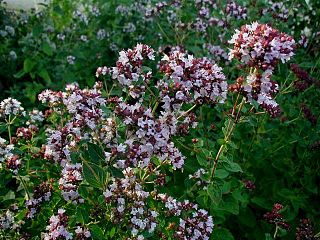
Origanum is a genus of herbaceous perennial flowering plants and subshrubs in the family Lamiaceae. They are native to Europe, North Africa, and much of temperate Asia, where they are found in open or mountainous habitats. A few species also naturalized in scattered locations in North America and other regions.

Orchis is a genus in the orchid family (Orchidaceae), occurring mainly in Europe and Northwest Africa, and ranging as far as Tibet, Mongolia, and Xinjiang. The name is from the Ancient Greek ὄρχις orchis, meaning "testicle", from the appearance of the paired subterranean tuberoids.
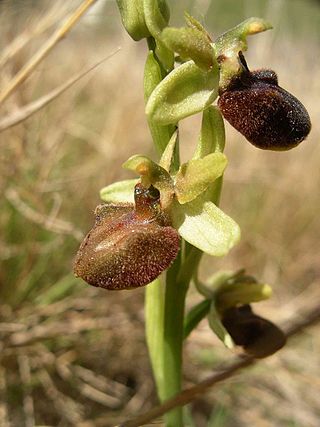
Ophrys sphegodes, commonly known as the early spider-orchid, is a species of sexually-deceptive orchid native to Europe and the Middle East. It is a very varied species with many subspecies recognised.

Micromeria is a genus of flowering plants in the mint family, Lamiaceae, widespread across Europe, Asia, Africa, and North America, with a center of diversity in the Mediterranean region and the Canary Islands. It is sometimes placed within the genus Satureja. The name is derived from the Greek words μῑκρος (mīkros), meaning "small," and μερίς (meris), meaning "portion," referring to the leaves and flowers. Common names include savory and whitweed.
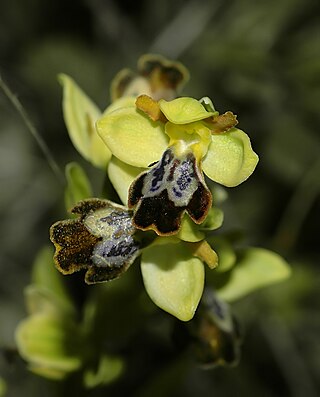
Ophrys fusca, commonly known as the sombre bee-orchid or the dark bee-orchid, is a species of orchid native to the Mediterranean from southwestern Europe and northern Africa to western Asia. Most subspecies of the Ophrys fusca are pollinated by males Andrena bees.

Ophrys omegaifera, the omega bee-orchid, is a species of orchid native to the Mediterranean region from Portugal and Morocco to Syria.

Ophrys reinholdii is a species of orchid. Its native range from Croatia in southeastern Europe to northwestern Iran in western Asia, including Bulgaria, Greece, Turkey and Cyprus.
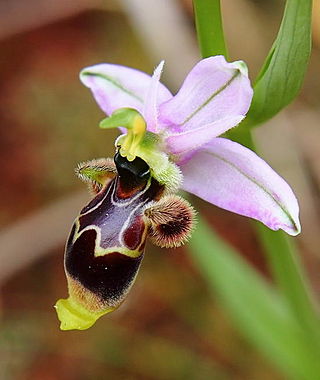
Ophrys scolopax, known as the woodcock bee-orchid or woodcock orchid, is a species of terrestrial orchid found around the Mediterranean and the Middle East, from Morocco and Portugal to Hungary and Iran.

Ophrys argolica, the late spider orchid, or Argolian bee-orchid, is a terrestrial species of orchid native to Greece, Italy, Croatia, Cyprus, Turkey, Lebanon and Syria. The epithet "argolica" refers to the Argolia region of Greece, southwest of Athens.

Ophrys kotschyi, the Cyprus bee orchid, is a terrestrial species of orchid native to Greece and Cyprus.

Sedum eriocarpum, the purple stonecrop, is a small, annual, succulent herb, 3–6 cm high, with hairless, reddish-green stems. Leaves succulent, simple, entire, spirally arranged, hairless, stalkless, elliptical to oblong, 3–15 x 2–8 mm, green or green-reddish. Flowers actinomorphic, petals white with purplish keel. It flowers from March to May and the fruit is a follicle.

Dianthus strictus, known as the wild pink, is a species of flowering plant in the family Caryophyllaceae.

Ophrys sphegodes subsp. taurica, with many synonyms, including Ophrys caucasica, is a subspecies of orchid native from southeast Europe through the Caucasus to Iran. As Ophrys caucasica, it has been recorded in numerous areas throughout Armenia, Azerbaijan, Georgia and Russia. Local names include Armenian: Սարդակիր Մեղվակիր, romanized: Sardakir mexvakir, Azerbaijani: xarı-bülbül and Georgian: ფუტკრის-დედა, romanized:put'k'ris-deda.

Anthemis cretica, the Cretian mat daisy or white mat chamomile, is a species of flowering plant in the family Asteraceae. It or its many subspecies can be found around the Mediterranean region, the Black Sea area, Poland, the Caucasus, and the Middle East as far as Iran. It is highly morphologically variable, and the namesake of a species complex.
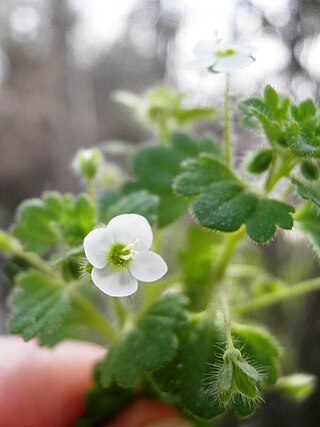
Veronica cymbalaria, the pale speedwell, glandular speedwell or cymbal speedwell is a species of flowering plant in the Plantaginaceae (Plantain) family. It is native to countries surrounding the Mediterranean and a little further afield, and has been introduced to parts of the Americas and New Zealand.

Ophrys holosericea, the late spider orchid, is a species of flowering plant in the family Orchidaceae, native to western and central Europe and the Mediterranean region. There has been considerable confusion about the identity of this species and the correct spelling of its name.

Juncus heldreichianus is a large tufted species of rush in the family Juncaceae, formed of two subspecies.
Dryopteris pallida is a species of fern.



















